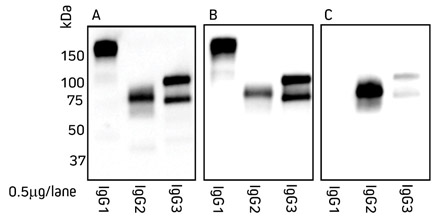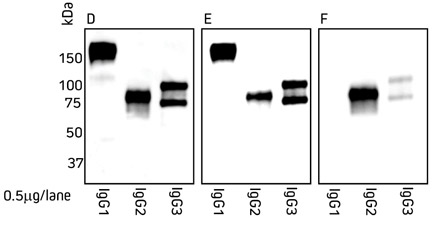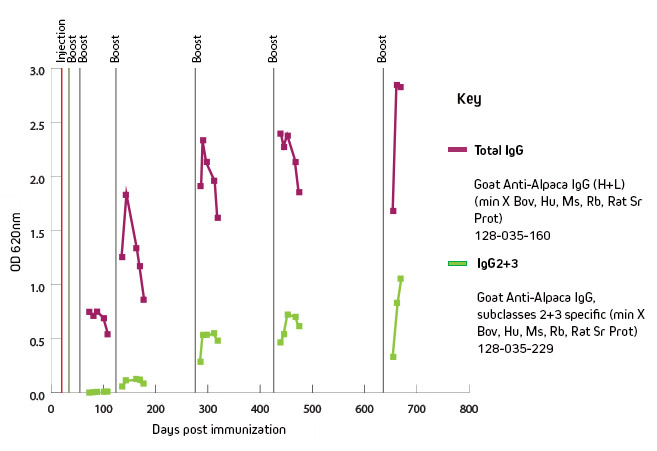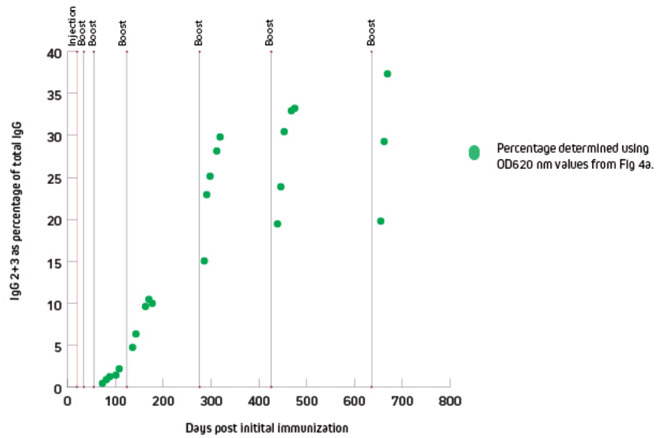Camelid single-domain antibodies are increasingly utilized in immunological methods of analysis, diagnostics and research. To support the growing adoption and need of camelid-derived Immunoglobulin technologies and VHH-antibody production, Jackson ImmunoResearch offers three new secondary antibody specificities for detection and quantification of camelid antibodies.
Three IgG-Subclasses (IgG1, IgG2 and IgG3) are found in camelid serum (Alpaca, Llama, Camel, Vicuna and Guanaco). Learn more about the structure of theses IgG-Subclasses.
Detection of camelid IgG subclasses by Western Blot
Anti-Alpaca (H+L) and Anti-Alpaca IgG2+IgG3 from Jackson ImmunoResearch recognize both alpaca and llama IgG. Figures 1 and 2 detail the detection of IgG subclasses from both species by Western blot.
IgG subclasses purified from serum (protocol according to Maass et al., 2007) were separated by SDS/PAGE under non-reducing conditions. Gels were blotted onto nitrocellulose membranes and probed with HRP-conjugated secondary antibodies (dilution: 1:20.000). Proteins were detected using chemiluminescent substrate and imaged for 5 min.

Blot A, Goat Anti-Alpaca IgG (H+L)-HRPO 128-035-003; Blot B, Goat Anti-Alpaca IgG (H+L)-HRPO [MinX Bo,Hu,Ms,Rb,Rt] 128-035-160; Blot C, Goat Anti-Alpaca IgG2+IgG3-HRPO [MinX Bo,Hu,Ms,Rb,Rt] 128-035-229.

Blot A, Goat Anti-Alpaca IgG (H+L)-HRPO 128-035-003; Blot B, Goat Anti-Alpaca IgG (H+L)-HRPO [MinX Bo,Hu,Ms,Rb,Rt] 128-035-160; Blot C, Goat Anti-Alpaca IgG2+IgG3-HRPO [MinX Bo,Hu,Ms,Rb,Rt] 128-035-229.
Determine the ideal time point for PBMC harvest
The development of engineered Nanobodies* can be initiated by immunizing an alpaca or llama with an antigen of interest. Monitoring of the immune response enables a researcher to harvest PBMCs at an optimal time.
Anti-Alpaca secondary antibodies from Jackson ImmunoResearch can be used to distinguish between total IgG and heavy chain antibodies in camelid serum during the immunization regimen. The heavy chain (IgG2 and IgG3) antibody response may mature differently from total IgG, and harvest of PBMCs producing VHH (from heavy chain antibodies) can be optimized.
Seroconversion (antigen-specific antibody titers) can be monitored by ELISA or by flow cytometry/FACS (Pardon et al., 2014). Anti-Alpaca IgG (H+L) can be used to monitor pre-immune and post-immune seroconversion. However, as shown in figure 3, generation of heavy chain antibodies may not be predicted by total IgG readings. Anti-Alpaca IgG2+IgG3 is ideally suited to measure heavy chain antibody serum conversion to enable optimal timing of PBMC harvest and to increase the yield for VHH library construction.
After immunization with the antigen of interest, ELISA was used to characterize the specific antibody response. The protein of interest was coated onto the ELISA plate, antiserum was used as the primary antibody source, and peroxidase-conjugated secondary antibody 128-035-160 or 128-035-229 was used to detect total IgG or IgG2+IgG3, respectively.


Total IgG titer suggest an ideal time point of PBMCs harvest at 150 days, but the IgG2 and IgG3 response remain relatively weak until after 300 days post immunization.
We have 3 new specificities in our portfolio!
Anti-Alpaca IgG (H+L)
| wdt_ID | Secondary Antibodies | Art.-Nr. |
|---|---|---|
| 1 | Goat IgG anti-Alpaca IgG (H+L) ** | 128-005-003 |
| 2 | Goat IgG anti-Alpaca IgG (H+L) [MinX Bo,Hu,Ms,Rb,Rt] ** | 128-005-160 |
Anti-Alpaca IgG2 + IgG3
These antibodies recognize both alpaca and llama IgG2- and IgG3-subclasses in serum and PBMCs, without cross-reaction to IgG1.
| wdt_ID | Secondary Antibody | Art.-Nr. |
|---|---|---|
| 1 | Goat IgG anti-Alpaca IgG2+IgG3 [MinX Bo,Hu,Ms,Rb,Rt] ** | 128-005-229 |
** Please note, these antibodies react primarily with the Fc region, and are not recommended for detection of VHH antibodies.
Here you can find VHH-specific antibodies and more information.
Anti-Alpaca IgG secondary antibodies are available with the following conjugates:
• Unconjugated
• Horseradish Peroxidase
• Alkaline Phosphatase
• Biotin
• DyLight™ 405
• Alexa Fluor® 488
• Fluorescein (FITC)
• Cy™ 3
• R-Phycoerythrin
• Alexa Fluor® 594
• Rhodamine Red-X™
• Alexa Fluor® 647
• Cy™ 5
Literature:
For more information about antibodies from camelids:
- Arbabi-Ghahroudi, M. (2017). Camelid Single-Domain Antibodies: Historical Perspective and Future Outlook. Front. Immunol. 8, 1-8.
- Daley, L.P., Gagliardo, L.F., Duffy, M.S., Smith, M.C., and Appleton, J.A. (2005). Application of Monoclonal Antibodies in Functional and Comparative Investigations of Heavy-Chain Immunoglobulins in New World Camelids. Clin. Diagn. Lab Immun. 12, 380-386.
- Maass, D.R., Sepulveda, J., Pernthaner, A., and Shoemaker, C.B. (2007). Alpaca (Lama pacos) as a convenient source of recombinant camelid heavy chain antibodies (VHHs). J. Immunol. 324, 13–25.
- Pardon, E., Laeremans, T., Triest, S., Rasmussen, S.G.F., Wohlkönig, A., Ruf, A., Muyldermans, S., Hol, W.G.J., Kobilka, B.K., and Steyaert, J. (2014). A general protocol for the generation of Nanobodies for structural biology. Nat. Protoc. 9, 674-693.
- Wagner, H.J., Sehrle, S. Weiss, E. Cavallari, M., and Weber, W. (2018). A Two-Step Approach for the Design and Generation of Nanobodies. Int. J. Mol. Sci. 19, 1-16..
AffiniPure™ Antibodies is trademark of Jackson ImmunoResearch Laboratories, Inc.
*Nanobody is a registered trademark of Ablynx N.V
DyLight™ fluorescent dyes is a trademark of Thermo Fisher Scientific.
Cy™ is a registered trademark of GE Healthcare.
Rhodamine Red™-X is a trademark of Invitrogen.
Alexa Fluor® is a trademark of Life Technologies Corp.
Images property Jackson ImmunoResearch Laboratories, Inc.
